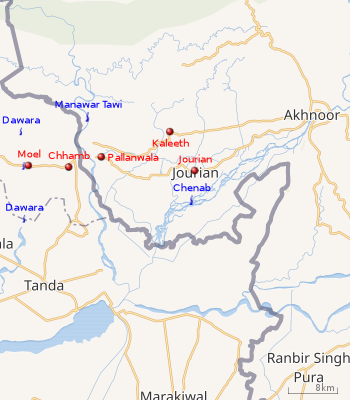Operation Grand Slam
Operation Grand Slam was a key operation of the 1965 Indo-Pakistani War. It refers to a plan drawn up by the Pakistan Army, in May 1965, to attack the vital Akhnoor Bridge in Jammu and Kashmir. The bridge was not only the lifeline of an entire infantry division in Jammu and Kashmir, but could also be used to threaten Jammu, an important logistical point for Indian forces. The operation ended in a failure for the Pakistan Army as the stated military objectives were not achieved and they subsequently were forced to retreat following a counterattack by the Indian Army.
 |
| Chhamb-Jourian-Akhnoor sector shown on a contemporary map. (The cease-fire line in effect in 1965 ran roughly along the Dawara stream to the west of Moel.) |
Background
Following the Rann of Kutch affair, which resulted in territorial gains for Pakistan following a boundary award later in 1968, the political atmosphere in Pakistan was jubilant. Believing the Indians were badly demoralised and the Muslims of Jammu and Kashmir would revolt against them with a little help, General Ayub Khan gave his approval for Operation Gibraltar, a plan to provoke uprisings in Jammu and Kashmir by infiltrating teams of military personnel to conduct sabotage and prod the Kashmiri people against Indian forces. The infiltration started in the first week of August 1965, as Pakistani infantry infiltrated the border in teams of twos and threes, eventually swelling to more than 4000–5000[1] in number.
Identifying the insurgents as Pakistan Army regulars, India countered them by bringing in additional troops. The Indian Army also launched attacks on the logistical bases of the insurgents in Pakistan-administered Kashmir.
The Pakistani Army commenced Operation Grand Slam at 0500 hours on 1 September 1965. The aim was to ease the pressure on the 12th Division, which was defending against repeated Indian attacks, and to guard against the threat to the city of Muzaffarabad from the gain by Indian forces of strategic areas such as Hajipir pass in Pakistan-administered Kashmir.
Execution
The Akhnoor sector was lightly defended by four Indian infantry battalions and a squadron of tanks. The infantry was stretched thin along the border and the AMX-13 tanks were no match for the Pakistani M47 Patton and M48 Patton tanks. Against a militarily stronger and larger Pakistani thrust, the Indian forces retreated from their defensive positions. According to Pakistani military historian Major (retd.) A. H. Amin, the Pakistani forces in Operation Grandslam had a 6 to 1 advantage over Indian AMX-13 tanks, which were like 'matchboxes' in front of the Pakistani Pattons. In terms of artillery, Pakistan's 8 inch guns were superior to anything that Indians had at that time and had an overall superiority of 6 to 1.[2]
On the second day of the attack, the GOC of the 12th Infantry Division Major General Akhtar Hussain Malik, commanding the overall forces in the area, was replaced by Major General Yahya Khan, the GOC of the 7th Infantry Division, which delayed the attack by one day. Not only did this decision cause confusion among the Pakistani officer cadre, the delay also permitted the Indians to rush reinforcements to the sector. When the attack recommenced on 3 September, the Indian forces in the sector were sufficiently reinforced to hold out for a few more days, but they did not have the strength to launch a counterattack. As the attack carried on for two more days without any significant gains in territory, the Indian Army opened up a new front, on 6 September, across the sensitive state of Punjab in Pakistan. The advance of the Indian Army also threatened to cut across the right flank of the Pakistani attack. Realising the gravity of the threat, the Pakistani Army stopped its thrust into Kashmir and diverted forces to counter the Indian incursion.
References
- Bajwa, Farooq (2013). From Kutch to Tashkent: The Indo-Pakistani War of 1965. Hurst. ISBN 1849042306.
- Amin, Major A. H. "Pakistan army till 1965". defence analyst. pg 41. Archived from the original on 4 January 2012. Retrieved 27 September 2011.
External links
- Bharat-Rakshak Official Indian Account can be found here.
- Defence Journal A Pakistani Account of 1965.
- Air Commodore Syed Sajjad Haider on 1965 war and surrounding events
- Battle of Chhamb Pakistan Army War Diary of 1965 War.